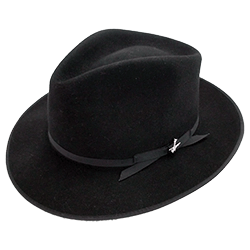Summer Essentials
Get ready for Summer!
Panama Hats
Style the Perfect Hat!
Get ready for Summer!
Style the Perfect Hat!
Fedora’s are a stylish hat that is generally made out of fur felt, wool or straw

Delve into the fascinating history of the Fedora, a timeless fashion piece with a backstory as intriguing as its design. From its inception in a 19th-century play to becoming a symbol of the women’s rights movement, and finally, achieving popularity among men – the history of the fedora is a captivating journey through time. This article provides an in-depth look at how this iconic hat has evolved and remained a staple in fashion over the years.
Table of Contents
ToggleThe fedora hat, renowned for its soft brim and indented crown, has long been a staple of stylish attire. Its unique design, typically featuring a crease lengthwise down the crown and a “pinch” near the front on both sides, has been coveted since as early as 1891. Over time, other crease styles such as teardrop crowns, diamond crowns, and center dents have emerged, adding to the charm of the fedora. Its popularity skyrocketed over time, overshadowing similar styles like the homburg.
An impressive attribute of the fedora is the versatility of its brim, which usually measures around 2.5 inches wide and can be finished in several ways. From a raw edge, left as cut, to a sewn overwelt or underwelt, or bound with a trim-ribbon, the brim can truly make a statement. More elaborate finishes, like the Cavanagh edge featuring invisible stitching, although no longer common in modern factories, are still sought after. However, small brimmed trilbies should not be mistaken with fedoras.
The fedora takes on more distinction through its various materials, ranging from wool, cashmere, rabbit, or beaver felt, to straw, cotton, or leather. Some are even made of exotic materials like vicuña, guanaco, cervelt, or mohair, adding an element of luxury to this timeless headpiece. Special variations of the fedora include rollable, foldaway, or crushable styles with open crowns that can be shaped in various ways. Features such as a ventilated crown for better air circulation, decorative small feathers, and a chinstrap, although less common, add to the appealing uniqueness of the Fedora.
At the height of the fedora’s popularity was from mid-1920s which is why it is often associated with Prohibition and gangsters. In 1940s and 1950s noir films popularized fedora hats even more and its popularity lasted until late 1950s, when informal clothing became more widespread.
It returned in mid-1970s and again in 1980s and in 2000s. Fedora and trilby hats were so fashionable because of their style and because of their practicality. They didn’t obscure the view while driving the car and were not as big as top hats so they could be worn in public transport. They could also be stored by folding without losing its shape.
But main reason for constant returning of the fedora to fashion should be looked for in media and its influence on people. In 1940s and 1950s, Hollywood brought back fedora by making movies in which fedora hat was a repeating icon of manliness and mystery worn such names as Humphrey Bogart and Cary Grant on celluloid and Frank Sinatra on the stage.
Legendary college football coach Paul Bear Bryant wore his trademark plaid and hounds-tooth fedora while standing near sidelines of games of his teams. Fedora was a part of his image that he is wearing it on the cover of the Time magazine. One more coach that made fedora an irreplaceable part of his attire was Coach Tom Landry, head coach of Dallas Cowboys from 1960 to 1988.
In seventies it was Indiana Jones that who brought revival of fedora to the silver screen. Television carries as much weight of responsibility for popularity of fedora as cinema… you will recall Indiana Jones wearing them while the music fanatics of days gone by cannot forget Michael Jackson from Smooth Criminal, Billie Jean, Dangerous to You Rock My World, where he spotted this hat. Simply epic!
In recent years many other musicians such are Justin Timberlake and Brittany Spears were wearing fedora in their live appearances and that has kept the fedora hat in fashion. Famous writer Terry Pratchett is known, among other things, for wearing a wide brim white fedora. In the last decade we’ve seen an explosion of shows, from Mad Men to Boardwalk Empire that depict characters being fashion conscious while retaining their masculinity.
Not coincidentally, these shows packed with tough men in snappy suits all take place in the past, with all the distance that affords. These shows provide an outlet for men who are interested in clothes, but retain the worry that this makes them appear feminine. Clinging to yesterday’s most iconic hat is a way to assert fashion sense without worrying about public perception.
Although it went in and out of the fashion throughout history, fedora was and will always be one of the most stylish hats ever!
Reference: https://en.wikipedia.org/wiki/Fedora
It was a symbol of He-man manliness and it made men seem like men.
Which is amusing because it got it’s start in the late 1800s as a woman’s hat style and got it’s name from a play where Sarah Bernhardt wore it as Princess Fedora Romanov. Personally, I love wearing them. I have a round face and curly hair. Fedoras looks nice. I also tie a long, sheer scarf around them like a hat band and let it trail in the back.
We have a 1960’s vintage Adam Man’s hat. Is it possible to buy a vintage style hatbox?